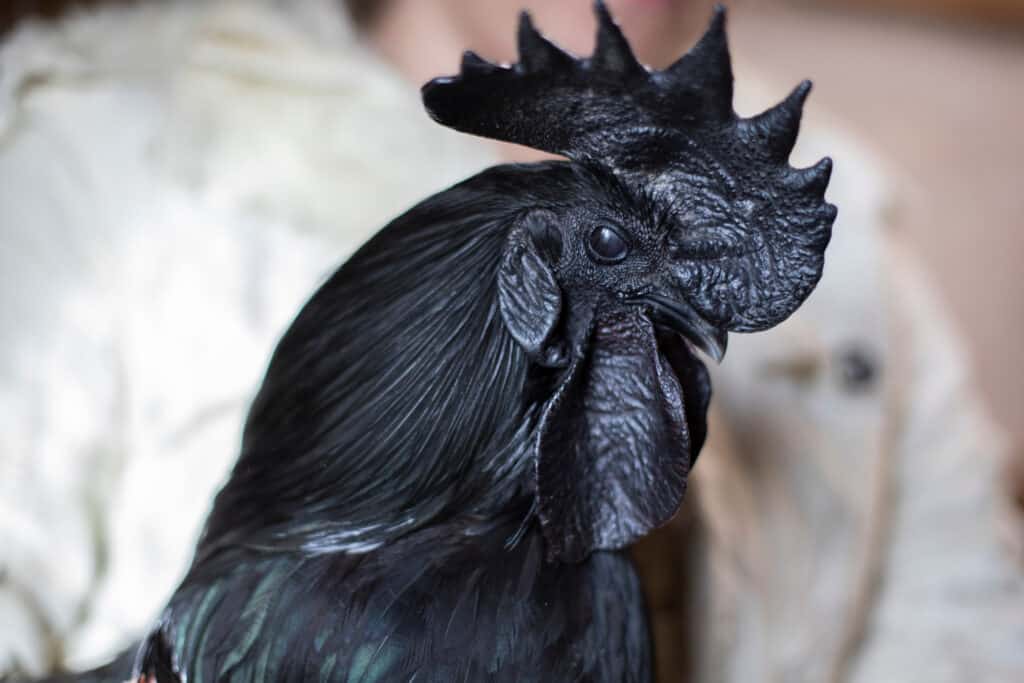Ayam Cemani
Ayam Cemani
They were used for sacrificial purposes
Advertisement
Ayam Cemani Scientific Classification
- Kingdom
- Animalia
- Phylum
- Chordata
- Class
- Aves
- Order
- Galliformes
- Family
- Phasianidae
- Genus
- Gallus
- Scientific Name
- Ayam Cemani
Read our Complete Guide to Classification of Animals.
Ayam Cemani Conservation Status
Ayam Cemani Facts
- Prey
- Grains, seeds, insects, and vegetation
- Main Prey
- Grain
- Name Of Young
- Chicks
- Group Behavior
- Mainly solitary
- Fun Fact
- They were used for sacrificial purposes
- Estimated Population Size
- 3,500
- Biggest Threat
- Bird flu
- Most Distinctive Feature
- Pitch black plumage
- Distinctive Feature
- Single comb and long wings
- Habitat
- Pastures and fields
- Predators
- Coyotes, foxes, birds of prey
- Diet
- Omnivore
- Lifestyle
- Diurnal
- Type
- Bird
- Common Name
- Ayam Cemani
- Special Features
- Strong legs
- Location
- Java, Indonesia
Ayam Cemani Physical Characteristics
- Color
- Black
- Dark Grey
- Skin Type
- Feathers
- Lifespan
- 6 to 8 years
- Weight
- 3.3 to 5.5 pounds
- Age of Sexual Maturity
- Less than one year
View all of the Ayam Cemani images!
“It is entirely black, including its organs and bones.”
Summary
The Ayam Cemani is an exceptionally rare chicken species native to Java, Indonesia, where they are highly regarded and used in sacrifices. People prize them for their excessive melanin, which covers them from head to toe, including their insides. These active, intelligent birds are also muscular and fast. Discover everything there is to know about the Ayam Cemani, including where they live, what they eat, and how they behave.
5 Amazing Ayam Cemani Facts
- There are only around 3,500 Ayam Cemani in the world.
- The American Poultry Association does not recognize these birds as a breed.
- They symbolize wealth and are often used for sacrificial purposes in Indonesia.
- The Ayam Cemani is not very vocal, except when they have to go in their coops for the night. They are active and like to spend their days pecking at the ground.
- Breeders have to incubate their eggs artificially because these birds don’t like to sit on them.
Where to Find the Ayam Cemani
These birds are native to Java in Indonesia, a volcanic island between Sumatra and Bali. The Ayam Cemani is not common; it is referenced as a status symbol for the wealthy and used for sacrificial purposes in its native land. However, beginning in 1998, they were transported to Europe and the United States. Though still extremely rare, you can occasionally find them from breeders in other countries. They spend their days roaming pastures and fields, pecking at the ground, searching for anything they can eat.
Ayam Cemani Nest
These birds typically live on private farms or breeding facilities. They use a nest box lined with straw to lay their eggs.
Scientific Name
Ayam Cemani (Gallus Gallus Domesticus) is a rare breed from the chicken family and genus. Ayam is Indonesian for “chicken,” and Cemani is a Javanese (ethnic Indonesian group) word for “thoroughly black.” The American Poultry Association (APA) does not currently recognize them as a breed. There is debate on how these birds came to be. Some believe they were developed, while others believe they come from the Ayam Bakisar breed, a mixture of red and green jungle fowl.
Size, Appearance, & Behavior

Ayam Cemani are alert and attentive, spending their days plucking at the ground and protesting when it’s time to settle in for the night.
©Sakss/Shutterstock.com
Ayam Cemanis are medium-sized fowl, with roosters weighing between 4.4 and 5.5 pounds and hens around 3.3 and 4.4. These birds are strong, muscular, and much faster than other chickens. Their beaks, tongues, combs, wattles, meat, organs, and bones are black or dark gray. They have hyperpigmentation, which makes them entirely black from head to toe. Their black feathers are soft and glossy, with a green and purple iridescent sheen. These chickens also have a single comb, long wings, broad shoulders, and strong legs.
Ayam Cemani are alert and attentive, spending their days plucking at the ground and protesting when it’s time to settle in for the night. They are active, intelligent, and adaptable, often unfazed by the things around them. However, they can be pretty standoffish and take time to socialize with other birds. They are also solid fliers and relatively quiet, only crowing once daily.
Diet
The Ayam Cemani is an omnivore who eats mostly anything.
What Does the Ayam Cemani Eat?
Like other chickens, this species eats what it can find as it pecks around its territory. It eats mainly grains, seeds, vegetation, insects, grubs, fruit, and vegetables. They like to free range on pasture all day and will often vocally protest when they have to return to their coops.
Predators, Threats, and Conservation Status
The Ayam Cemani is not listed on the IUCN Red List of Threatened Species. Therefore, we do not know this species’ exact conservation status. However, this chicken has a small population across a limited range, and many consider it extremely rare. The greatest threat to this bird is avian influenza (bird flu), which causes cough, lethargy, fluid build-up, and loss of appetite.
What Eats the Ayam Cemani?
Like other chickens, Ayam Cemani can fall victim to predators like coyotes, foxes, birds of prey, raccoons, possums, skunks, and snakes. Their eggs and young are especially vulnerable to predators. But thankfully, their black color gives them camouflage at night.
Reproduction, Young, and Molting
Ayam Cemani females can begin laying eggs less than a year old. They lay between one and two eggs weekly, around 60 to 100 per year. But are not known for being great egg layers and will stop producing for months at a time. They also don’t hatch their own eggs often, so eggs are hatched through artificial incubation. Their eggs are relatively large; despite what many believe, they are not black. They are a pinkish-cream color. This chicken’s average lifespan is between six and eight years.
Population
The global population of mature individuals of Ayam Cemani is unknown. However, they are estimated to have less than 3,500 left worldwide. Most of their population resides on farms and breeding centers.
Similar Animals:
View all 194 animals that start with AAyam Cemani FAQs (Frequently Asked Questions)
Where are the Ayam Cemani from?
These birds are native to Java in Indonesia, a volcanic island between Sumatra and Bali.
Can you find Ayam Cemani in the United States?
They are exceptionally rare, but you can sometimes find them from breeders in the US and Europe.
How big are Ayam Cemani?
Ayam Cemanis are medium-sized fowl, with roosters weighing between 4.4 and 5.5 pounds and hens around 3.3 and 4.4.
Are Ayam Cemani insides black?
Their beaks, tongues, combs, wattles, meat, organs, and bones are black or dark gray. They have hyperpigmentation, which makes them entirely black from head to toe.
Are Ayam Cemani loud?
They are relatively quiet, only crowing once in the morning and occasionally protesting at night.
What do Ayam Cemani eat?
Like other chickens, this species eats what it can find as it pecks around its territory. It eats mainly grains, seeds, vegetation, insects, grubs, fruit, and vegetables.
What threatens the Ayam Cemani?
The greatest threat to this bird is avian influenza (bird flu), which causes cough, lethargy, fluid build-up, and loss of appetite.
Thank you for reading! Have some feedback for us? Contact the AZ Animals editorial team.
















